Jumat, 04 Maret 2011
How to Install Google Analytics on Blogger
Diposting oleh
ayo Indonesia
Wouldn’t it be nice to know how many people actually visited your blog each day? How about knowing which of your posts are the most popular? Well surprisingly Blogger doesn’t currently offer any native blog analytics but fortunately there is Google Analytics — available for free. Google Analytics is a great tool that will show you all sorts of useful information about how people found your blog, keywords they searched on to find you, where they came from and even how long they stayed.
You’ll learn more about where your visitors come from and how they interact with your blog. This is a must tool if you are trying to build a profitable blog otherwise you are flying blind! This article will show you how to add Google Analytics to your Blogger blog. It’s a fairly simple process and doesn’t require any technical skill at all.
You’ll learn more about where your visitors come from and how they interact with your blog. This is a must tool if you are trying to build a profitable blog otherwise you are flying blind! This article will show you how to add Google Analytics to your Blogger blog. It’s a fairly simple process and doesn’t require any technical skill at all.
Step #1 – Setup a Google Analytics Account
Go to Google Analytics and sign in using your Blogger login. If your account doesn’t work for some reason, you can create a new one instead. Once you login you’ll see a screen that looks like this:

Click on the “Sign Up >>” button and proceed to the next step which will ask you for your general information. Website URL, Account Name, Country, and Time Zone. The screen will look like this:
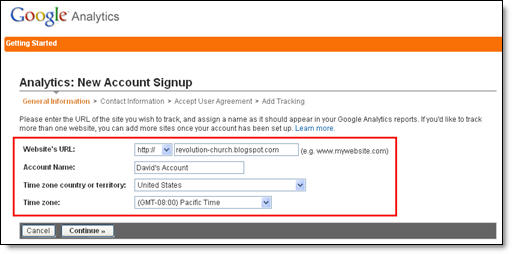
If you noticed, I just put my Blogger url (without the http://) and called it “David’s Account” because this is your top-level container for 1 or 100 different websites so it’s a good idea to name it something more general. The next step will ask you for your contact information which includes your first name, last name, phone number, and country. Easy so far right?
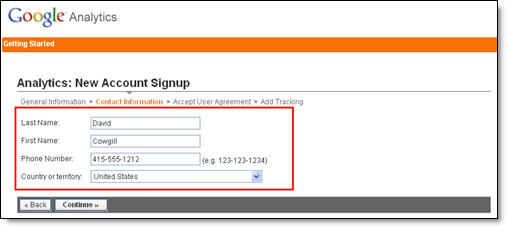
Your last step in signing up will ask you to accept the user agreement terms and conditions which you should read (just kidding…who actually ever reads these entire legal terms anyhow?).
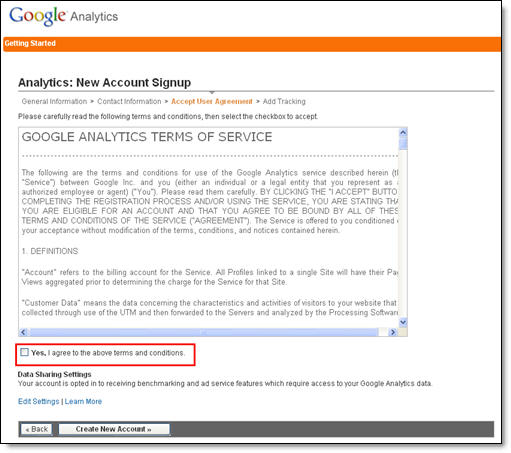
Now this next screen is very important. This is the code you will need to copy and paste into your blogger template. Go ahead and click into the box and it will automatically highlight the entire block of code for you. Now you need to copy that code and paste it into notepad or into a MS Word document. Save it as you’ll need to use it later.
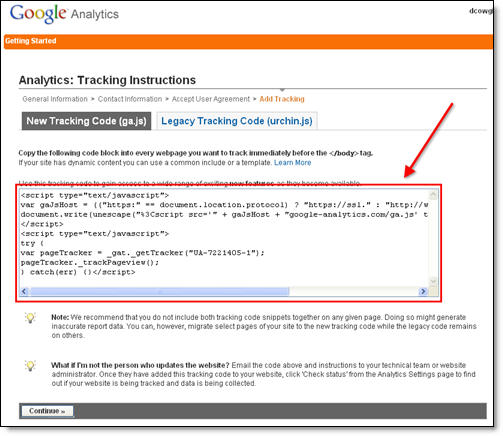
After you click on the “continue >>” button you will be taken to your brand new Google Analytics dashboard! You will see your blogger blog listed but with no analytical data….yet.
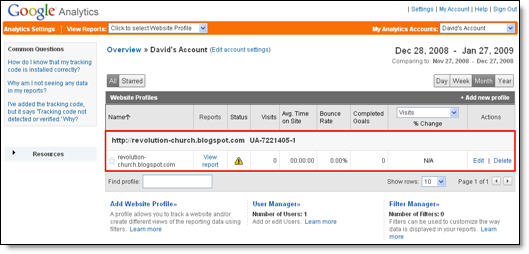
Ok, now you are done with setting up your Google Analytics account. The next step is placing the tracking code into your Blogger template so it can report back to Google Analytics and provide you with some cool data points.
Step #2 – Adding GA Tracking Code to Your Blogger Template
This is not a very difficult step even if you are afraid to touch your template code. Login to your Blogger account and then click on the “Layout” => “Edit HTML” tabs. This will bring you to the template code. Before you make any changes, I advice you to back up your template just in case there are any problems. After you’ve done so, continue reading. Now in the edit template html code window, scroll all the way to the bottom of your template code and look for the
</body> tag. There should only be one of these closing tags in your template. If you can’t find it then your template wasn’t properly created and you should add one right above the </html> tag.The </html> tag should always be your last line of code in your template. It signifies the end of your template.Ok, now go back to the code you saved before in a Word Doc from Google Analytics. You are going to copy it and paste it right above the
</body> tag as illustrated in the image below. The yellow highlighted code is the new GA code I just pasted into my template.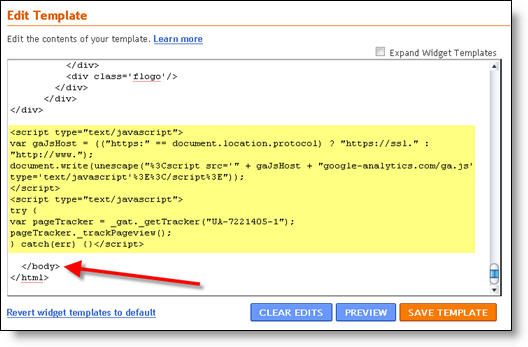
Save your template and you shouldn’t get any error messages. If you do, it’s most likely not related to this GA code and something else with your template itself. Assuming you’ve been successful with your save, you are all done embedding the GA code in your template!
Step #3 – Confirm Google Analytics is Tracking
Go back into your Google Analytics account and look at your dashboard. Most likely you will see a little yellow exclamation mark under the “status” column that looks like this:  . This means everything isn’t working properly yet which is fine because we are about to tell GA we just added the code. From your dashboard, click on the “edit” link which is located to the far right.
. This means everything isn’t working properly yet which is fine because we are about to tell GA we just added the code. From your dashboard, click on the “edit” link which is located to the far right.
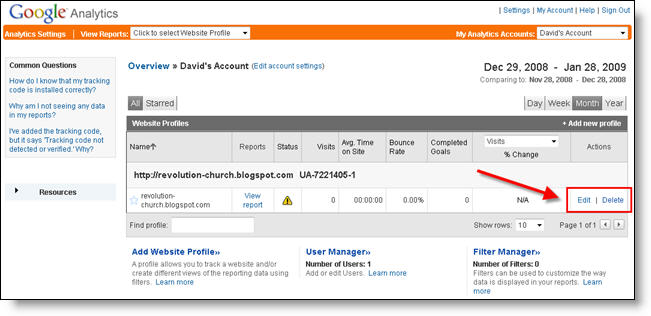
After you click on that link, you’ll see another screen like below. It will say “Tracking Not Installed” followed by a link “Check Status”. You’ll want to go ahead and click on that link which will tell GA to visit your site and look for the new code you just pasted in your template.
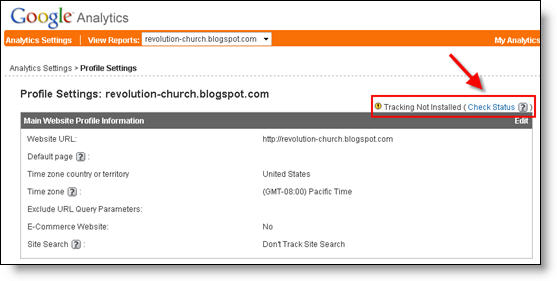
Assuming you pasted the code in there as instructed above, GA will find the new code and begin tracking everything on your blog. If you are still having problems, it’s most likely something to do with GA and you should read their help guide to troubleshoot your problem.

The message seen here, “Waiting for Data” means you have correctly setup GA and data is being gathered! Click on the top left Google Analytics logo and it will take you back to your dashboard. From there click on the “View report” link and that’s where all your very important Blogger visitor data will start appearing!
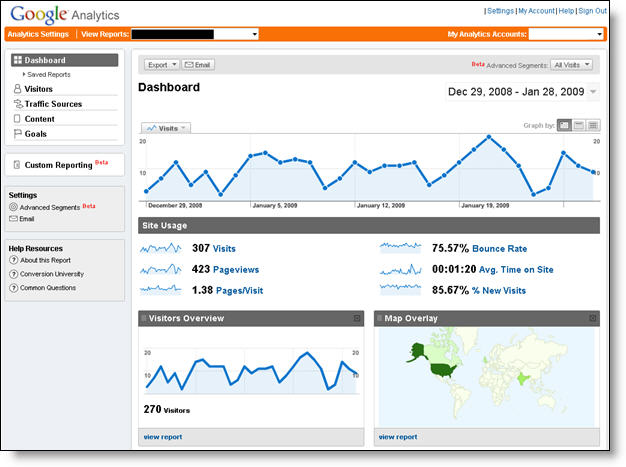
Now it usually takes an hour or so before you will see any data (maybe longer if you don’t get much traffic to your blog) so please be patient. Trust me, you’ll be logging in at least once a day just to see how much traffic your blog is getting. It’s very addicting and powerful information to learn from. You’ll be surprised which posts are your most popular and what countries people are coming from to read your blog.
Google Analytics is very powerful and we have just learned how to install it into your Blogger template. We haven’t even scratched the surface on the features and reporting it can do. For most Bloggers, this will be enough. Data will be collected and you will just review it. Others with more in-depth goals (like selling products or services, creating a sales funnel, etc) will want to spend more time learning GA. Hope you enjoyed the tutorial and don’t blame me for your new found addiction!
Blog Archive
-
▼
2011
(496)
-
▼
Maret
(162)
- Remeh dan Kerdil
- Artikan Sendiri Maknanya, Saya Juga Bingung.......
- Memberi PASSWORD pada folder dengan dan tanpa soft...
- Facebook Mobile Prompt Feed XSS (Cara Iseng Ngerja...
- Membuat burung twitter terbang di blog - Floating ...
- Cara mengawasi facebook pasangan kita dengan multi...
- Solusi Buka Facebook di blok IT dengan browsing am...
- cara iseng promosi web atau blog di salingsapa.com
- Daftar Web Penyedia Jasa URL / Link Shortener
- Simple Javascript Floating Image, Object, Avatar,...
- Free download SLANK mp3 Full All album
- Domain Dot TK saya tiba-tiba menghilang
- Metode Kepahlawanan
- RW KESEDIHAN RT KEBUNTUAN
- Fake Mailer / Fake Email Sender / Email Palsu
- DARI HATI KE HATI
- Apa Besok Pagi Kita Belum Mati ?
- Sistem Nilai Apakah yang Kita Pilih
- Menghapus Blog Yang Kita Ikuti (Follow)
- Files And Archives of p4r46hcyb3rn3t
- Kenapa Saya Gagal Blogging?
- Islam itu tidak menyakiti siapa-siapa
- Pekerjaan Yang Mulia
- Kepada Siapakah Engkau Mengeluh?
- Dua Manusia Super Di Pinggir Jalan
- Saatnya Untuk Pulang
- Saya Anti Demokrasi.....!!!
- Manusia Bukan Tandingan Setan
- Kita Adalah Bangsa Yang Memang Tidak Perlu Rajin
- Ketika Gandhi Kehilangan
- Modal Utama Manusia Untuk Menjadi Muslim Bukan Al ...
- Bakwan Jengkol
- 10 Tips untuk Blogger Pemula
- Meningkatkan Pendapatan Adsense Anda
- Memasang Iklan Google Adsense Di Blog Bahasa Indon...
- Hikayat Bukit Tengkorak
- Namanya Melisa
- Saya Jadi Apa, Bukan Karena Ingin
- Kebenaran Dibalik Sebuah Berita
- Apakah Kita Sudah Assalamu'alaikum Wr. Wb.
- Cara Menghapus Crawl Error Dengan Webmaster Tools
- Langkah-Langkah Membuat Website
- Panduan Google Website Optimizer untuk Split Testing
- Panduan / Tutorial Menggunakan Google Adwords
- Dapatkan Pay Per Lead $5 dari Nifty Stats
- Cara Membuat Rekening PayPal-100% Gratis
- Belajar Tools dan Tips Google Adsense
- Apa Arti Sebenarnya Bisnis Online itu?
- Macam-Macam Program Affiliasi Website
- How to Make Money From Your Website
- Social Widget [Twitter, Facebook & RSS Feed] Plugi...
- Top 15 WordPress SEO Plugins for 2010
- 10 WordPress plugins to work with images
- Akismet Key and How to Resolve Akismet Detected Pr...
- Cara Promosi Blog Anda
- Cara Mendaftarkan Blog ke Search Engine
- Membuat Website Search Engine Friendly
- Using the Joomla! Contact Component
- Tutorial Joomla – Using the Media Manager for File...
- Tutorial Template Joomla
- Joomla: Bagaimana Menghilangkan Jcomments Footer Link
- JComment: Fasilitas Komentar Joomla yang Simple ta...
- Joomla : Ubah Favicon Joomla Sesuka Hati
- Membuat Domain Dot Com dengan Blogspot
- Cara Daftar Gratis Domain di Web.Id
- Daftar Domain Gratis dari dot Tk
- Membuat Domain Gratis di CO.TV
- Daftar Penyedia Domain Gratis
- Cara Membuat Daftar Isi dan Sitemap Blog WordPress
- Cara Membuat Daftar Isi pada Blog WordPress
- Membuat file Robots.txt di Worspress
- Membuat Sitemap pada Wordpress
- Membuat Artikel Terkait (Related Post) pada Blog W...
- Cara Memasang Iklan di Dalam Postingan Blog WordPress
- Membuat Link Di Wordpress
- Membuat Iklan Melayang (Floating) di WordPress
- Cara Instalasi WordPress Di Local Host
- Instalasi CMS WordPress Pada Server Hosting
- Cara Daftar di Domain Gratis, Free Domain, Free DN...
- Pengaturan DNS Pada Domain CO.CC
- Membuat Website Atau Blog Gratis Penghasil Uang
- Platinum SEO Plugin-The Ultimate WordPress SEO
- Membuat Album Foto pada WordPress CMS dengan Plugi...
- Cara Optimasi Blog WordPress Bagi Pemula Dengan Pl...
- Tips Untuk Free Web Directory
- How to Activate Akismet to Your WordPress Blog
- 9 Anti Spam WordPress Plugin
- Optimalisasi WordPress untuk Mesin Cari
- Cara Mudah Membuat Blog WordPress Terkenal
- Plugin to Speed Up Your WordPress Site
- WordPress Optimization for Better Performance and ...
- WordPress Easy Paypal Payment or Donation Accept P...
- Activate Our WordPress RSS With Feedburner
- Tutorial Daftar Hosting Gratis DI FREEHOSTIA
- Instal Wordpress di Hosting Byethost
- Beware Free Hosting With 000WebHost.com
- Panduan mendaftar Hosting di Hostgator
- Tutorial Membuat Domain Gratis .CO.CC
- Tutorial Membuat Hosting 000webhost
- What Is Website Webhosting
-
▼
Maret
(162)